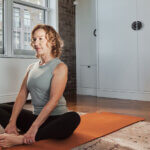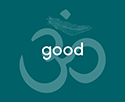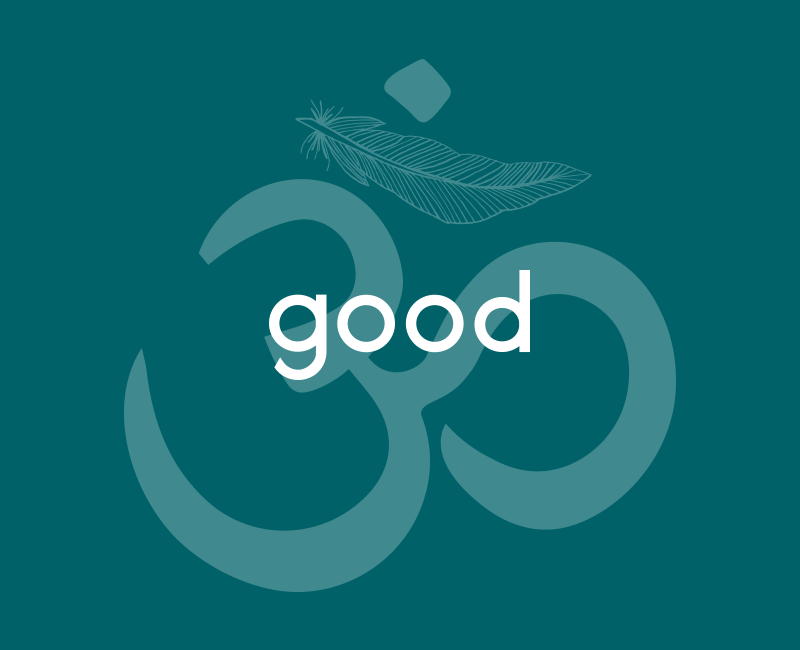Once you mastered the basics of yoga, you may crave the excitement of a little bit of a challenge. It’s time to add intermediate yoga poses to your daily routine. These exercises are perfect to enhance your yoga skills while building up your strength to do even more. So, if you’re ready to expand your yoga experience, try these 10 intermediate poses.
1. Boat Pose Navasana
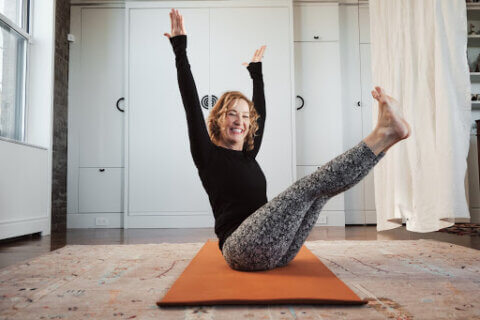
You’ll likely encounter this pose in all levels of yoga classes. This pose isn’t necessarily considered an ‘intermediate’ pose, but it’s foundational for the strength and flexibility you need for many intermediate and advanced yoga poses going forward.
Boat pose strengthens the core muscles from hip flexors to the spinal column and everything in between. It’s also a great way to start creating inner heat.
How to Get Into Navasana
From a seated position with your legs extended forward, raise your arms to shoulder height with the palms facing each other (thumbs up). Bend your knees and place your hands at the backs of your thighs. Lean back and so that you’re balancing on the bony part of your seat, referred to as your “sit bones”.
Lengthen through your spine so that your chest lifts and you broaden across your collar bones. Resist rocking back and rounding in your low back (lumbar spine)! Keep deeply flexing at the hips, lifting your chest, and contracting your shoulder blades.
From here you have options to strengthen towards the full expression of the posture:
Option 1: Place your hands at the back of your thighs, keeping your shins parallel to the floor, and maintain this position for 5-7 breath cycles.
Option 2: Keep the knees bent, shins parallel to the floor, and extend your arms forward, palms facing each other. Maintain balance on the sit bones and lift in the chest. Hold 5-7 breath cycles.
Option 3: Keep the arms as they are and extend at the knees, pointing the soles of your feet up and away, toes about the same height as your nose. Maintain balance on your sit bones and length along your spine, without rounding into your low back. Hold this for 5-7 breath cycles.
Option 4: For the full expression, keep the integrity of your spinal alignment and lift in your legs while you raise your arms up to frame your head
Why You Should Try This Pose
- This posture strengthens nearly all of the “core” muscles: psoas, abdominals (including obliques) and the erector spinae muscles along the spine.
Pro Yoga Tip: Bend the legs if the full extension makes your stomach shake. For a variation, hold your toes.
2. Eagle Pose Garudasana
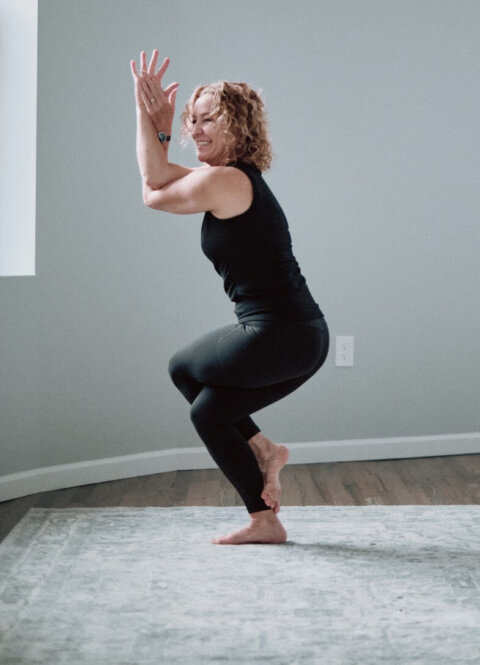
Eagle pose, or Garudasana, is a great pose to find confidence in your balance. It’s also a wonderful counter option to many of your typical yoga poses.
Our qualified yoga teachers will tell you that some intermediate yoga poses open your chest and contract your back. Instead, the eagle pose contracts the front of your body instead.
How to Get Into Garudasana
Stand in Mountain Pose (Tadasana). For options, place a block to the outside of the right foot. With your hands on your hips, bend your knees and sit back into Fierce Pose (Uttkatasana).
Now bring your weight onto your right foot. Lift your left leg and cross your left thigh over the right. Here we get into options and modifications as you work towards various expressions of this intermediate yoga pose.
Option 1: place a block on the outside of your standing leg and put your toes of your crossed leg on it
Option 2: wrap the foot of the lifted leg around the calf of your standing leg
Your arms now extend out to the sides, shoulder height. Bring your arms in front of you, crossing the left arm under the right, and bend your elbows. Here are some options to work into the upper part:
Option 1: the backs of your hands touch and you’re wrapped up enough!
Option 2: if this seems too difficult at first, bring your forearms and elbows together, shoulder height, palms touching (you’re twisted enough!)
Option 3: if you’re really into being twisted, keep wrapping your arms until your palms touch.
Regardless of how twisted you are, keep squeezing everything in towards the middle, as you press down through the standing leg. Lengthen upwards towards the top of your head. Your arms stay parallel to the ground, and you can breathe towards the space between your shoulder blades.
Exit Garudasana by unwinding and spreading the arms wide and kicking the upper leg out to the side as you remain on the standing leg before you return to Mountain Pose.
Why You Should Try This Intermediate Yoga Pose
- Excellent for improving balance, increasing proprioception strength, especially around the ankles
- Helps relax the shoulders and release tension between the shoulder blades
Pro Yoga Tip: Try the options with the block when your balance feels off. You can also do the arm options alone when you are at your desk to relieve shoulder and neck tension.
3. Ardha Chandra Chapasana
A variation of Balancing Half Moon pose, ardha chandra chapasana is one of the more challenging intermediate yoga poses for sure. By now, you probably feel confident balancing on one foot in Warrior III or Tree Pose.
Try chapasana – a balancing pose with an asymmetrical backbend. When mastered, you will experience an even greater sense of concentrated focus that happens especially when we do balancing postures.
How to Get Into Ardha Chandra Chapasana:
With the right leg in front, make your way into Warrior II pose. Place your left hand on your hip, and with your right hand, reach towards the floor and beyond the pinky toe side of the right foot. Begin to lift the left heel off of the floor, as you propel yourself towards standing on your right foot.
Your hips are in an “open” position, nearly stacked, and your left leg is lifted in the air. Be sure to have your gaze, or drishti, fixed on a point for balance. Now, bend your lifted left leg and reach for the top of the foot with your left hand. (You can grab either the inner or outer side of your ankle).
An option here includes lifting the lower hand from the floor and create gyan mudra, touching the tip of the index and thumb together, and pointing the tips of the thumb and index fingers towards the center of your chest at your heart.
Why This is One of the Best Intermediate Yoga Poses
- A great way to get a taste of the kind of focus and concentration that comes from meditation!
- Strengthens proprioceptors, opens hips and adductors, increases knee stability
Pro Yoga Tip: Keep the foot of your lifted leg flexed at the ankle and the muscles of both legs strongly engaged. This will help keep you steady as you hold the pose.
Additionally, when you attempt to lift the lower hand away from the floor, put a slight bend in the standing leg to help facilitate moving it away from the floor.
4. Dolphin Pose Ardha Pincha Mayurasana
Dolphin pose is a fantastic foundation for so many intermediate yoga poses, we had to add it to this list. You’ll gain core strength, open your shoulders, and find the ability to maintain your concentration.
The goal is to slowly build towards holding this yoga pose for longer periods of time. Holding Ardha Pincha Mayurasana will help build your resolve and bolster determination.
How to Get Into Ardha Pincha Mayurasana
Start in a forearm plank. Your elbows are just about shoulder-distance apart and your forearms are parallel. Slowly walk your feet forward, your hips will begin to elevate. Your knees are extended (“straight”) and your heels are sinking towards the floor.
Build the length of time that you stay in this pose.
Why You Should Try the Dolphin Pose
- Opens shoulders and back
- Strengthens upper arms and core muscles
- Helps reduce fatigue
- Preparation for many types of inversions and arm balances
Pro Yoga Tip: Your legs can be bent or straight. Classically, your forearms are parallel, however, your shoulder structure may feel better with the hands moving in towards each other.
If this feels better, either clasp your hands or put them flat on the mat with the thumbs and index fingertips touching.
5. Crow Bakasana
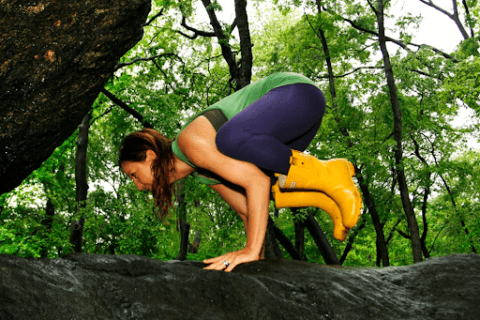
Crow pose or Bakasana is a great entry point into the world of arm balances. This pose is also a huge confidence builder especially with overcoming fears!
You’ll want to do this after warming up your shoulders and hips. And remember, the “takeoff” comes as much from your core strength as it does from your arm strength.
How to get Into Crow pose
Stand with your feet together, and slowly bend your knees. You should be nearly squatting on the balls of your feet, with your heels lifted. Separate your knees, lean forward slightly, and place your palms on the floor in front of you, about shoulder-width apart.
Lean further forward and put more of your body weight onto your hands. Lift your heels and hips so your knees get as high up on your outer upper arms as possible. Squeeze your knees in towards your arms, lean a bit further forward and take one or both heels towards your buttocks. Your elbows will bend slightly.
You’re flying!
Why the Crow is One of the Best Intermediate Yoga Poses
- Builds confidence
- Improves focus and concentration
- Strengthens core and upper body muscles
Pro Yoga Tip: Don’t look down! Keep your gaze, or drishti forward. Getting the knees up as high on your arms and squeezing the legs in is key, so you may want to start by stepping onto a block.
6. Sleeping Vishnu Pose Anantasana
Sleeping Vishnu pose, or Anantasana is deceptively challenging. It requires stability from your core muscles in order to stay balanced on your side while you hold one leg in the air. This is why we had to include it on our list of intermediate yoga poses.
How to Get Into Anantasana
Lie on your side with the lower arm extended by your ear under your head. Bend that arm at the elbow and use that hand to prop up your head. Your feet are strongly flexed as you engage the muscles of both legs.
Bring your upper knee in towards your stomach. Grab the big toe of that foot with the peace fingers of your hand in a yogi toe lock. First, extend the knee and bring your foot forward, and then take your foot and leg upwards (out to the side) towards the ceiling.
You’ll need to keep the lower leg and your core muscles very strongly engaged in order not to topple over.
Why You Should Try This Pose
- Promotes joy and bliss
- Improves balance
- Strengthens inner thigh and core muscles
Pro Yoga Tip: When you topple out of this pose, LAUGH! It will greatly improve your mood and remind you to take yourself, and your practice a little less seriously.
7. Upward Plank Purvottanasana
Upward plank is a nice counterpose to the numerous postures we do that contract and strengthen the muscles of your chest. It is also wonderful for spinal alignment and increasing movement of breath into the upper lungs and chest. So, it’s one of the most beneficial intermediate yoga poses on this list.
How to Get Into Purvottanasana
Sit on your mat with and place your hands behind you with your fingers facing towards you. Extend your legs forward. Strongly press the soles of your feet towards the floor, and lift your hips.
Why You Should Try This Pose
- Boosts energy and opens the front of the chest.
- Strengthens muscles of the thighs
- Builds healthy triceps and rhomboids, the muscles on the backs of your arms and between your shoulder blades
Pro Yoga Tip: Working at your desk all day? You can do this in your office chair (as long as it doesn’t have wheels!). Slide your feet forward under your desk, bring your hands to the sides of the chair seat, press into your feet, and lift your hips.
It will energize you and counter that forward desk hunch!
8. Camel pose Ustrasana
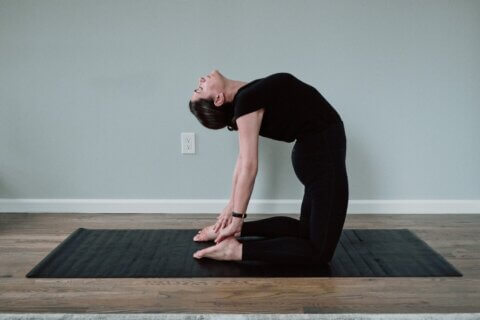
Camel pose is a challenging backbend because unlike other backbends, the knees and shins are anchored as they form the base of the pose.
Depending on how your back is feeling that day, there are many options to ease or deepen the experience in this intermediate yoga pose, while still receiving the benefits of a backbend.
How to Get Into Ustrasana
From kneeling, curl your toes under. Take your hands behind you and place your palms on the hips near either side of your spine, fingertips pointing down. Begin to lift the front of your chest, your sternum, as you press your thighs and pelvis forward.
Engage your rhomboids, the muscles between your shoulder blades. This will broaden your collar bones more, and allow you to deepen the backbend. At this point, you can stay here.
Or, if you’d like, you can slowly reach your hands down towards your heels towards a deeper backbend. If you do this, keep the head aligned with the top of your spine. Keep pressing the hips and thighs forward, and engage the muscles between your shoulder blades even more.
To come out of this intermediate yoga pose, slowly return to kneeling and move into vajrasana or balasana.
Why Include This in Your Intermediate Yoga Poses
- Strengthens the entire back chain of muscles: hamstrings, gluteus, spinal extensors, and rhomboids.
- Helps open the chest and throat, supporting the respiratory diaphragm
Pro Yoga Tip: As an intermediate step, place a bolster or block on your calves to reach towards instead of going straight for your heels.
Keep your drishti towards the point above the tip of your nose and don’t let the head “hang” back.
9. Dancer Pose Natarajasana
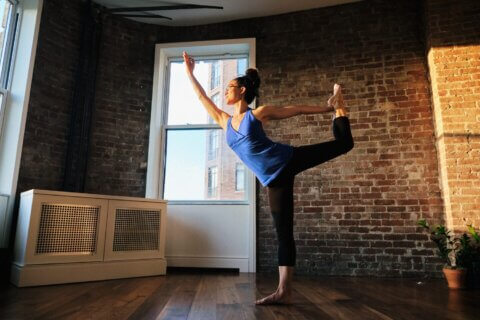
Natarajasana is another asymmetrical backbend and balancing posture that fosters concentration, focus, and joy. It’s one of our favorite intermediate yoga poses on this list, so make sure you try it when you feel ready.
How to Get Into Natarajasana
Begin in Mountain Pose (Tadasana) and place your hands on your hips. Bring your weight on one foot, and bend the other knee so the heel comes towards the buttock. Externally rotate the arm on the lifted leg side by sweeping it out to the side and behind you. Clasp the inside of the ankle.
Lift the arm on the standing leg alongside your ear, and join the thumb and index fingers in jnana mudra. Start to hinge forward from your standing hip joint, and actively press the foot into the hand. As the sole of that foot projects up towards the ceiling, create a backbend along your spine, lifting the sternum.
Draw your navel in towards your spine, and keep the muscles of the standing leg active without locking the knee.
Why This is a Great Intermediate Yoga Pose
- Raises energy level
- Opens the chest and breathing muscles
- Improves the standing leg’s joint alignment, and stretches the lifted leg’s quadriceps
Pro Yoga Tip: Keep your hips facing forward and avoid splaying the lifted leg’s knee out to the side by continuing to internally rotate that thigh.
10. Hand to Foot Pose, Pada Hastasana
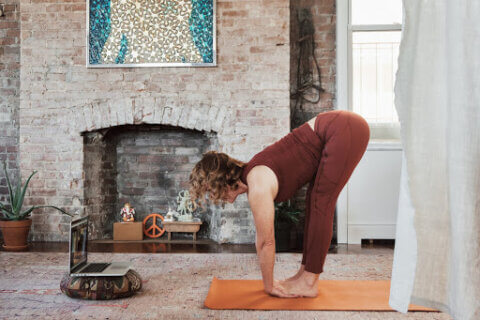
Hand to foot posture creates space in the spine, stretches the backs of your hamstrings, and creates traction in the wrists and shoulders. Overall, it’s calming to your nervous system.
It’s also a great counterpose to backbends and many of the deep wrist flexions that we do in yoga with downward dog, plank, and arm balances.
It’s last on our list of intermediate yoga poses because it’s also a great pose to start the unwind from your daily yoga routine.
How to Get Into Pada Hastasana
From Mountain Pose (Tadasana) move into a forward fold, Uttanasana. Flex your feet strongly, shifting your weight temporarily towards your heels to lift your feet off of the floor.
Place your hands underneath your feet, palms up and facing the bottom of your feet. Slide the hands under the feet enough that the tips of your toes are grazing the creases of your wrists. Balance the weight of your body across the soles of your feet, creating more pressure on the hands.
Allow your elbows to move out, left and right, and move your shoulders away from your ears. Engage the muscles of your thighs, lift your sit bones, and pull upwards on your hands.
Why You Should Try This Pose
- Soothes the nervous system
- Stretches the back body
- Strengthens the quadriceps and releases the neck and shoulders
- Counterpose for wrists and back
Pro Yoga Tip: Knees can be slightly bent if you can’t easily reach your feet. Press the fronts of your thighs towards the backs of your thighs. Even though we teachers often say “lift your shoulders away from your ears” your shoulders are anatomically moving down the back.
Want More Intermediate Poses? Try Online Yoga Classes
If you’d like to try more intermediate yoga poses, or you’d like some more guidance on how to develop them, online yoga classes can help you build up your strength and experience. The Soule Collective offers unlimited online yoga classes, so you can try these poses from the comfort of your home.
Check out our classes and try us out!











